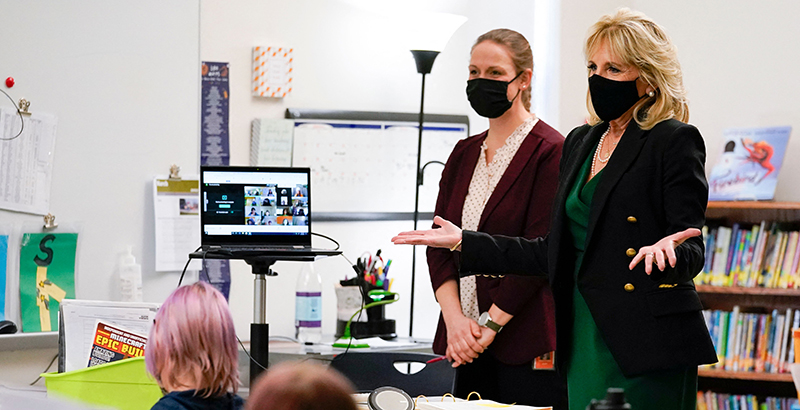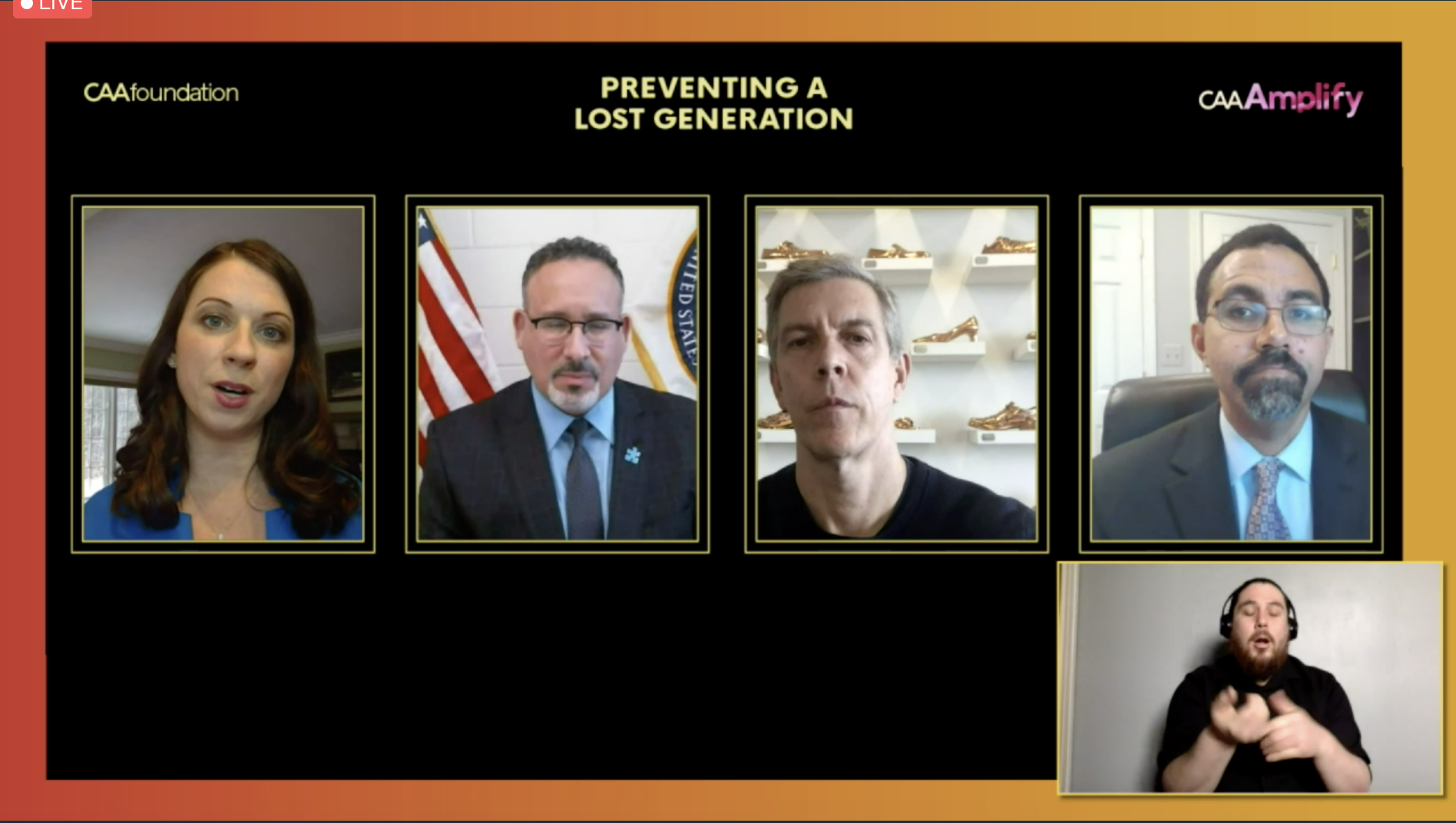CDC’s About-Face on Social Distancing Likely to Pave Way for More Children to Return to Class, but Teachers Unions Express Skepticism

Updated
Three feet of social distancing is sufficient in classrooms as long as students wear masks, according to new Centers for Disease Control and Prevention guidance announced Friday.
But 6 feet should be maintained between adults and students, in common areas and during activities such as singing or exercise, the CDC said. In situations where community transmission rates are high, the guidance said middle and high school students should be kept six feet apart unless they are taught in small groups. The update also removes a recommendation that schools place physical barriers between students.
“I think this will matter,” Emily Oster, a Brown University economics professor, who has conducted research on the issue, said about the changes.
The decision adds weight to parents’ and district leaders’ push to get more students back in school full time. Scientists largely agree 3 feet, which is a more common standard in schools outside of the U.S., is acceptable as long as mask wearing is strictly enforced. But teachers unions are expressing skepticism after being largely supportive of the Biden administration’s push to reopen.
“While we hope the CDC is right and these new studies convince the community that the most enduring safety standard of this pandemic—the 6-foot rule—can be jettisoned if we all wear masks, we will reserve judgement until we review them, especially as they apply in districts with high community spread and older buildings with ventilation challenges, American Federation of Teachers President Randi Weingarten said in a statement.
National Education Association President Becky Pringle had stronger words, saying the guidelines would be “particularly challenging for large urban school districts and those without the resources necessary to fully implement the very COVID-19 mitigation measures that the CDC says are essential to safe in-person instruction.”
National polls have shown that Black parents are nearly twice as likely as white parents to say they won’t send their children back to in-person learning.
Both Pringle and Weingarten have said that it’s important to have more research on the distancing guidelines from diverse, urban schools. Those schools might be older and lack the kind of updated ventilation systems the CDC views as part of a“layered” approach to making schools safe to reopen.
Muting ‘negative reactions’
Leslie Finger, an assistant professor of political science at the University of North Texas, said that coming on the heels of the $1.9 trillion federal relief package, any criticism of the guidance from the AFT and NEA will likely be mixed with continued support for the Biden administration.
“I imagine the new stimulus funds going to school districts will help mute negative reactions to the 3-feet guidelines,” she said.
And Dale Chu, a senior visiting fellow with the conservative Thomas B. Fordham Institute, said the 3-feet rule is generally a win for both sides. “School reopening proponents feel like their concerns have been heard while the unions can wax skeptical and maintain appearances of having the backs of their locals,” he said.
In a briefing Friday, CDC Director Rochelle Walensky addressed the union’s lobbying efforts to keep the guidance unchanged. “I’ve spoken to the teachers unions,” she said. “They know we need to follow the science.”
Finger added, however, that some local union affiliates will have “harsher criticism” for districts that move ahead with closer spacing.
That’s already the case in Chicago, where the union voiced strong opposition to the Illinois State Board of Education reducing the requirement to 3 feet. Union President Jesse Sharkey suggested that the updated guidance won’t encourage more parents to bring their children back.
Even in districts where most students have returned, the guidance is unlikely to change the minds of parents who have opted to remain remote.
“I would think that there may be some families who would want to come back with the change, but anticipate that number being pretty low,” said Matt Miller, superintendent of the Lakota Local School District, north of Cincinnati, Ohio.
The importance of masking
The update comes about five weeks after the CDC issued strategies for schools to reopen, including maintaining 6 feet of distance. Since that time, officials have “continually reviewed the evolving evidence on … transmission in K–12 schools, as well as the latest science on the effectiveness of different prevention strategies,” according to the release.
In addition, the CDC released the results of three studies that it says support the new guidelines, but also reinforce the mask requirements — from Florida, St. Louis and Salt Lake City. Walensky said that as long as schools are strict about mask requirements, students should still be protected against the more serious variants of the disease, which have led to more children becoming sick in European countries, such as Italy.
“The same mitigation strategies — the masking, the distancing — work just the same with the variants as they do with the wild-type disease,” she said.
In the United States, the argument over distance will likely be the most heated in areas that have been the slowest to reopen. Some states, such as Utah, have already been using 3 feet as a guideline, and some have even been spacing students as they did before the pandemic, according to Dr. Daniel Benjamin, a professor of pediatrics at Duke University who has studied the effects of reopening schools in North Carolina.
“The guidance on 6 feet originated in early March of 2020, prior to recognition of the importance of masking,” Benjamin said. “Moving to 3 feet at all education levels is both supported by the data and important for children’s health through improved access to the support provided by school.”
Keith Watkins, the assistant director of facilities for the City School District of New Rochelle in New York and past president of the National School Plant Management Association, said the speed at which schools will make the shift will likely be a “mixed bag.”
“Many schools have already developed plans and numbers for what this will look like,” he said of the change to 3 feet. “I think many are sitting back and waiting to see what other states, and their neighbors do.”
In districts that are currently using hybrid schedules, where only half of their students are in schools at a time, the new guidance means they could bring all students back five days a week, while allowing some families to continue to opt for virtual classes.
“If lower physical distancing policies can be adopted in schools without adversely affecting our students, it will enable more students to return to the classroom for a much needed traditional face-to-face education,” Broward County Public Schools Superintendent Robert Runcie said in a statement from Chiefs for Change.

Miguel Cardona holds his Safe School Reopening Summit next Wednesday. On Thursday, in a conversation with former secretaries Arne Duncan and John King, Cardona discussed the additional $10 billion for COVID-19 testing schools will receive from the federal government. That’s on top of the $122 billion in the most recent relief bill specifically for K-12.
“I anticipate [schools] to be open in the fall, but I want them to be open in the spring,” he told Julia Rafal-Baer, chief operating officer for Chiefs for Change. “We hope that that can help spur that movement.”
Get stories like these delivered straight to your inbox. Sign up for The 74 Newsletter

;)
